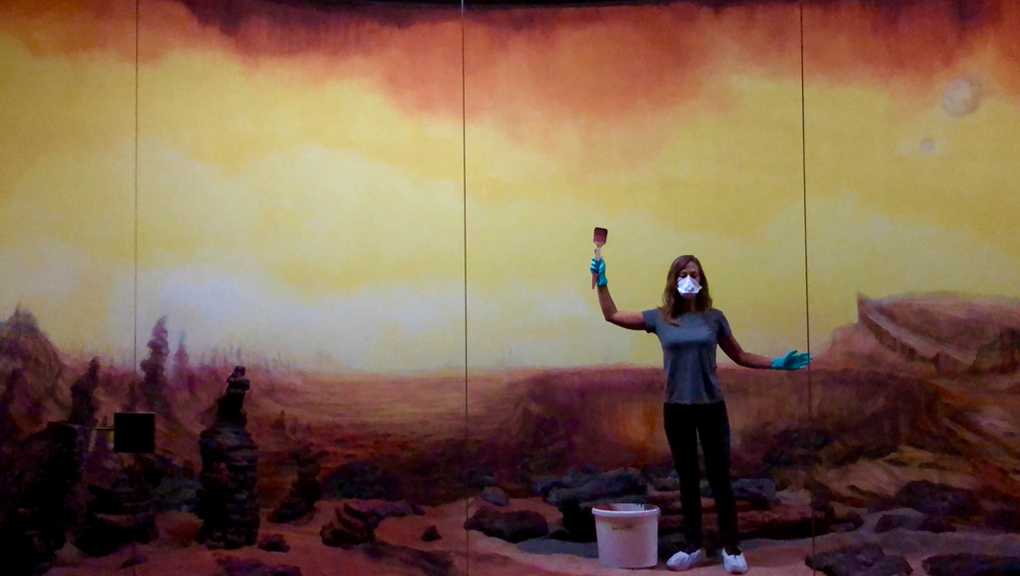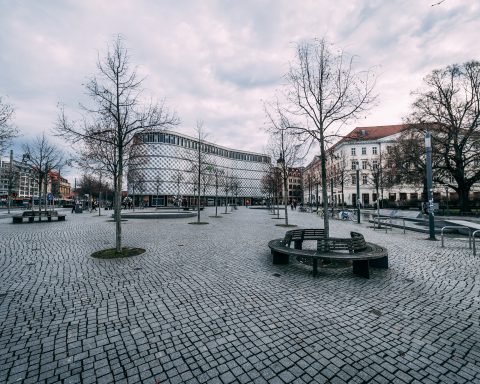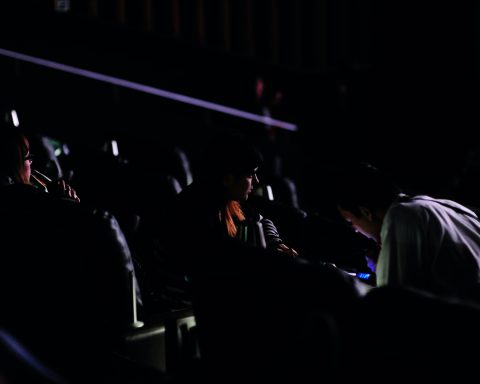Our gaze is cast again on the red planet. Stoked by a seemingly unending list of references, among them tales by Edgar Rice Burroughs, Ray Bradbury, Leigh Brackett, and Philip K. Dick, to a slew of Hollywood movies and recent documentaries and series hosted on Netflix, Mars has seeped into our culture, our consciousness, entered our dreams, and riddled our thoughts about the future.
My recent journey to Mars originates from an opportunity to work on a diorama created for artist Dominique Gonzalez-Foerster’s exhibition Martian Dreams Ensemble, under the tutelage of master dioramist Joi Bittle.
The exhibit at the Galerie für Zeitgenössische Kunst (gfzk) in Leipzig is on view through 17 February 2019.
The lure for me to participate in such an endeavor stems from an interest in examining the development and use of landscape imagery, its implications within an expanded field of painting, and its entanglement in contemporary culture. My own artistic work and research often refers to the utilization of landscape as a medium of culture and an instrument of social, economic, and political ideologies, pronounced during this current era by complex feelings of extreme anxiety and uncertainty.
As we continually become more physically separated from each other and from nature, how are landscape representations viewed and discussed from the relative distance and confines of our interiors and virtual environments? How do representations of place shape its value, and how is landscape utilized as simulation?

The diorama, as both concept and structure, provides still fertile grounds for such questions, and serves well as a platform for framing our desires for the real-unreal. American diorama painter James Perry Wilson, renowned for his dioramas at natural history museums, described the creation of a diorama using the Latin phrase ars celare artem, or “art to conceal art.”
It is an art to conceal art; true art conceals the means by which it is achieved. The primacy of this aesthetic value expressed during the last two centuries of spectacle culture continues its relevance within contemporary simulations. However, as the dioramas we might think of in natural history museums often depict scenes observed from the natural world, it is interesting to note the construction of a landscape that exists as an actual location, but upon which no one has actually set foot.
We understand Mars as a real place; we construct it with detailed visualizations in our mind without any human ever having been there before.
Our understanding of the geology and geography of Mars is no doubt fulled by the probes and rovers sent there during the past decades, making images of the planet clearer in our minds, and simultaneously increasing the perceived potential for its habitability.
Musing on going to Mars today, one must consider the role of Elon Musk, particularly his founding of SpaceX, a company that has, according to its website, “the ultimate goal of enabling people to live on other planets.” For Musk, travel to Mars is not only a natural step in the evolution of life to become a multi-planet species – a space faring civilization – but a necessary one if we humans are to survive in the face of catastrophic events, such as a third world war.
Insights may be drawn from a conversation with Elon Musk that occurred a few weeks ago on The Joe Rogan Experience (now infamous for a blunt toke) – specifically when host Joe Rogan inquired about simulation, a topic Musk has previously discussed at length. The discussion that followed involved Musk’s assertion that we are most likely already in a simulation. Assuming that we could also be in base reality, that we’re not in a simulation just yet, Rogan then drew parallels to a contemporary desire for what I describe as a perceived physical materiality, that is to say, what we think of as real, tangible things.
The examples listed during the conversation between Musk and Rogan included mason jars, suede shoes, craft restaurants, raw wood, metal, a “longing towards some weird, log cabin-type nostalgia.” To which Musk responded, “Sure. Reality. But then, people will go get a mason jar with a wine stem or a handle – that’s dark. Makes me lose faith in humanity. […] Made with the wine stem, made with the handle – it was manufactured like that.”
I now know that the making of a cold and desert-like surface environment, in the form of an analog diorama, involves massaging circles of paint into a primed white wall to create a sky, sawing and hacking sheets of Styrofoam then covering the pieces with a textured plaster mixture to create rocks, and churning buckets of sand and gravel spiked with raw pigments to create a Martian ground – the point is not lost on me for a desire of the real and the handmade.

Perhaps knowledge of how to build these tangible things, or inspiring a desire to learn, is something else preserved through the creation of such diorama installations.
Like the one-piece, wine-stemmed mason jar, maybe we want to consider all the elements of a diorama landscape as having always belonged together. Yet sensing an abomination, we may also want to visually pick them apart, pull back the curtain of art concealing art and see it as a representation or simulation. Perhaps we wish to be in the image of a painting as much as we wish to hold it in our hands as an object, to place it upon an elevated position or to tear it down and potentially toss it into a bin.
The craft, time, and work that goes into the creation of such a simulation is inherent. The tedium required in the making of an interesting simulation is also noted by Elon Musk. It became clear that Musk believes “most likely, just about probably,” there are many simulations running on a substrate. That substrate is plausibly boring. Arguing that “when we create a simulation, like a game or a movie, it’s a distillation of what’s interesting about life. […] So, most likely, if we’re a simulation, it’s really boring outside the simulation, because why would you make a simulation that’s boring? You’d make a simulation way more interesting than base reality.”
Unlike a virtual or AI-based reality, where the concept of place is nowhere (where are you when you’re in a computer?) within a 3-dimensional installation – or positioned before a room-scale diorama separated by a wall of glass, created from what is perceived to be real materials – one truly believes they know where it is that they stand. In the end, the model environment is not so different from the interiors of our own dwellings.

The perceivable boundaries of limitation such as walls, floors and ceilings house our objects of desire, provide isolation along with isolation, essentially functioning like boxes whose goods are perched upon pedestals cast in superficial lighting. Any simulation will be the byproduct of what it is we value, containing our cravings, disgusts and fears.
How are we, then, to enter Mars?
I think it is through a combination and hybrid of forms and media that we will traverse this planet. Until now, this has been the case. We have always gained access to other worlds through some sort of simulation; we play at and imitate the operation of Earth-world processes in environments composed of, for example, painted Styrofoam forms, computer models, or images gleaned from influential texts and music.
With the reality of the continual technological momentum, the question for me no longer becomes whether or not we could eventually live on Mars, but whether or not we should.
This notion is an old one. Though I entertain the thought of actually colonizing or occupying Mars, it is with extreme trepidation.
The arguments are impassioned and reasoned on both sides, leading me to question what becomes the greater risk. With this in mind, perhaps the desire of Elon Musk and others to make living on Mars a reality for humans should not only be seen as a backup plan in case we fail to get it right here on Earth. Rather, it should be perceived as a means to spark inspiration in humanity – for us to also look forward to the future.
Regarding our future, I’ll defer to a remark made by Musk himself, “I’d rather be optimistic and wrong than pessimistic and right.”
Cover shot: Martian Dreams Ensemble on view at GfZK through 17 Feb 2019.







